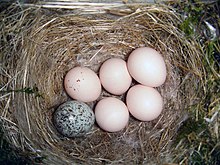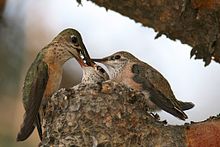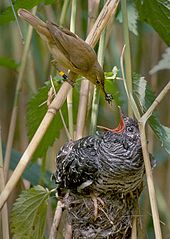

The length and nature of parental care varies widely amongst different orders and species. At one extreme, parental care in megapodes ends at hatching; the newly hatched chick digs itself out of the nest mound without parental assistance and can fend for itself immediately.[151] At the other extreme, many seabirds have extended periods of parental care, the longest being that of the Great Frigatebird, whose chicks take up to six months to fledge and are fed by the parents for up to an additional 14 months.[152]
In some species, both parents care for nestlings and fledglings; in others, such care is the responsibility of only one sex. In some species, other members of the same species—usually close relatives of the breeding pair, such as offspring from previous broods—will help with the raising of the young.[153] Such alloparenting is particularly common among the Corvida, which includes such birds as the true crows, Australian Magpie and Fairy-wrens,[154] but has been observed in species as different as the Rifleman and Red Kite. Among most groups of animals, male parental care is rare. In birds, however, it is quite common—more so than in any other vertebrate class.[39] Though territory and nest site defence, incubation, and chick feeding are often shared tasks, there is sometimes a division of labour in which one mate undertakes all or most of a particular duty.[155]
The point at which chicks fledge varies dramatically. The chicks of the Synthliboramphus murrelets, like the Ancient Murrelet, leave the nest the night after they hatch, following their parents out to sea, where they are raised away from terrestrial predators.[156] Some other species, such as ducks, move their chicks away from the nest at an early age. In most species, chicks leave the nest just before, or soon after, they are able to fly. The amount of parental care after fledging varies; albatross chicks leave the nest on their own and receive no further help, while other species continue some supplementary feeding after fledging.[157] Chicks may also follow their parents during their first migration.[158]
 Brood parasites
Brood parasitesMain article: Brood parasite
Reed Warbler raising a Common Cuckoo, a brood parasite.Brood parasitism, in which an egg-layer leaves her eggs with another individual's brood, is more common among birds than any other type of organism.[159] After a parasitic bird lays her eggs in another bird's nest, they are often accepted and raised by the host at the expense of the host's own brood. Brood parasites may be either obligate brood parasites, which must lay their eggs in the nests of other species because they are incapable of raising their own young, or non-obligate brood parasites, which sometimes lay eggs in the nests of conspecifics to increase their reproductive output even though they could have raised their own young.[160] One hundred bird species, including honeyguides, icterids, estrildid finches and ducks, are obligate parasites, though the most famous are the cuckoos.[159] Some brood parasites are adapted to hatch before their host's young, which allows them to destroy the host's eggs by pushing them out of the nest or to kill the host's chicks; this ensures that all food brought to the nest will be fed to the parasitic chicks.[161]
Ecology
 Birds occupy a wide range of ecological positions.[121] While some birds are generalists, others are highly specialised in their habitat or food requirements. Even within a single habitat, such as a forest, the niches occupied by different species of birds vary, with some species feeding in the forest canopy, others beneath the canopy, and still others on the forest floor. Forest birds may be insectivores, frugivores, and nectarivores. Aquatic birds generally feed by fishing, plant eating, and piracy or kleptoparasitism. Birds of prey specialise in hunting mammals or other birds, while vultures are specialised scavengers. Avivores are animals that are specialized at predating birds.
Birds occupy a wide range of ecological positions.[121] While some birds are generalists, others are highly specialised in their habitat or food requirements. Even within a single habitat, such as a forest, the niches occupied by different species of birds vary, with some species feeding in the forest canopy, others beneath the canopy, and still others on the forest floor. Forest birds may be insectivores, frugivores, and nectarivores. Aquatic birds generally feed by fishing, plant eating, and piracy or kleptoparasitism. Birds of prey specialise in hunting mammals or other birds, while vultures are specialised scavengers. Avivores are animals that are specialized at predating birds.Some nectar-feeding birds are important pollinators, and many frugivores play a key role in seed dispersal.[162] Plants and pollinating birds often coevolve,[163] and in some cases a flower's primary pollinator is the only species capable of reaching its nectar.[164]
Birds are often important to island ecology. Birds have frequently reached islands that mammals have not; on those islands, birds may fulfill ecological roles typically played by larger animals. For example, in New Zealand the moas were important browsers, as are the Kereru and Kokako today.[162] Today the plants of New Zealand retain the defensive adaptations evolved to protect them from the extinct moa.[165] Nesting seabirds may also affect the ecology of islands and surrounding seas, principally through the concentration of large quantities of guano, which may enrich the local soil[166] and the surrounding seas.[167]
A wide variety of Avian ecology field methods, including counts, nest monitoring, and capturing and marking, are used for researching avian ecology.
No comments:
Post a Comment